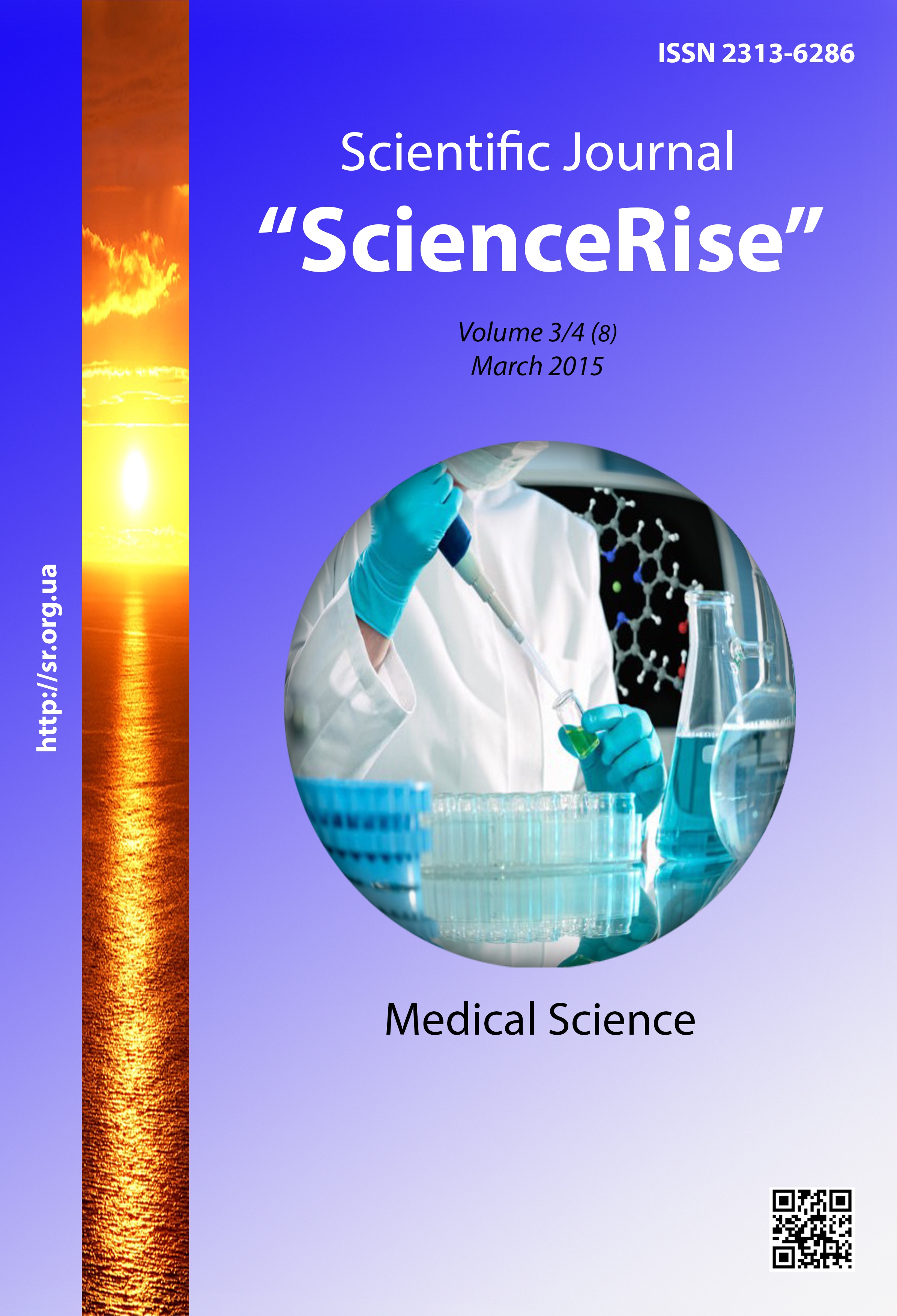Ethelial-mesenchymal transformation of papillary thyroid mcrocarcinomas
DOI:
https://doi.org/10.15587/2313-8416.2015.39327Keywords:
papillary thyroid microcarcinomas, epithelial-mesenchymal transformation, lymph nodes metastasesAbstract
Epithelial-mesenchymal transformation (EMT) in papillary thyroid cancer results in high risk of invasion and lymph node metastasizes. The aim of the study was to investigate the immunohistochemical features of EMT in papillary thyroid microcarcinomas (PTM) for identify morphological diagnostic features of tumor aggressive clinical behavior.
Methods. The immunohistochemical expression patterns of vimentin were examinated in central regions, invasion zones and lymph node metastases in 28 patients with PTM. It is investigated an expression of NIS, VEGF, MMP-9 and pan-cytokeratin in PTM with solid/trabecular pattern of growth and high level expression of vimentin.
Results. It is shown that microcarcinomas with high level expression of vimentin, exhibiting a solid/trabecular pattern of growth associated with increase MMP-9 (p<0,005), VEGF (р<0,05), and decrease NIS (р<0,005) level expression. These changes reflect phenotype of the epithelial-mesenchymal transformation and associated with the presence of metastases in cervical lymph nodes (p<0,001).
Conclusions. Epithelial-mesenchymal transformation which can be seen under routine H&E observation is an important indicator of lymph node metastasis of PTM.
References
Lloyd, R., De Lellis, R., Heitz, P., Eng., C. (2004). World Health Organization Classification of Tumours: Pathology and Genetics of Tumours of the Endocrine Organs. Lyon, France: IARC Press International Agency for Research on Cancer, 320.
Kim, W. J., Bae, M. J., Yi, Y. S., Jeon, Y. K., Kim, S. S., Kim, B. H., Kim, I. J. (2013). Clinicopathologic Characteristics of Papillary Microcarcinoma in the Elderly. Journal of Korean Thyroid Association, 6 (1), 69–74. doi: 10.11106/jkta.2013.6.1.693
Cappelli, C., Castellano, M., Braga, M., Gandossi, E., Pirola, I., De Martino, E. et. al. (2007). Aggressiveness and outcome of papillary thyroid carcinoma (PTC) versus microcarcinoma (PMC): A mono-institutional experience. Journal of Surgical Oncology, 95 (7), 555–560. doi: 10.1002/jso.20746
Yu, X.-M., Wan, Y., Sippel, R. S., Chen, H. (2011). Should All Papillary Thyroid Microcarcinomas Be Aggressively Treated? Annals of Surgery, 254 (4), 653–660. doi: 10.1097/sla.0b013e318230036d
Cho, J.-K., Kim, J.-Y., Jeong, C.-Y., Jung, E.-J., Park, S.-T., Jeong, S.-H. et. al. (2012). Clinical features and prognostic factors in papillary thyroid microcarcinoma depends on age. Journal of the Korean Surgical Society, 82 (5), 281–287. doi: 10.4174/jkss.2012.82.5.281
Koperek, O., Asari, R., Niederle, B., Kaserer, K. (2011). Desmoplastic stromal reaction in papillary thyroid microcarcinoma. Histopathology, 58 (6), 919–924. doi: 10.1111/j.1365-2559.2011.03791.x
Bondarenko, O. O. (2011). Diagnostic and outcome of malignant tumors of thyroid: immunohistochemistry aspects. Kharkiv, Ukraine, 20.
Virk, R. K., Van Dyke, A. L., Finkelstein, A., Prasad, A., Gibson, J., Hui, P. et. al. (2012). BRAFV600E mutation in papillary thyroid microcarcinoma: a genotype–phenotype correlation. Modern Pathology, 26 (1), 62–70. doi: 10.1038/modpathol.2012.152
Xing, M. (2009). BRAF Mutation in Papillary Thyroid Microcarcinoma: The Promise of Better Risk Management. Annals of Surgical Oncology, 16 (4), 801–803. doi: 10.1245/s10434-008-0298-z
Khoperia, V. G. (2011). Epithelial-mesechymal transformation: role in thr invasion of papillary thyroid cancer. Joints AMS Ukraine, 17 (4), 402–405.
Vasilenko, I. V., Kondratuk, R. B., Kudriashov, A. G. (2012). The features of epithelial-mesenchimal transformation in cancers of different localization and histology. Clincal Oncology, 5, 163–167.
Huber, M. A., Kraut, N., Beug, H. (2005). Molecular requirements for epithelial–mesenchymal transition during tumor progression. Current Opinion in Cell Biology, 17 (5), 548–558. doi: 10.1016/j.ceb.2005.08.001
Liu, Z., Kakudo, K., Bai, Y., Li, Y., Ozaki, T., Miyauchi, A. et. al. (2011). Loss of cellular polarity/cohesiveness in the invasive front of papillary thyroid carcinoma, a novel predictor for lymph node metastasis; possible morphological indicator of epithelial mesenchymal transition. Journal of Clinical Pathology, 64 (4), 325–329. doi: 10.1136/jcp.2010.083956
Wang, S. (2013). Differential expression of the Na+/I‑ symporter protein in thyroid cancer and adjacent normal and nodular goiter tissues. Oncol Lett., 5 (1), 368–372.
Maeta, H., Ohgi, S., Terada, T. (2001). Protein expression of matrix metalloproteinases 2 and 9 and tissue inhibitors of metalloproteinase 1 and 2 in papillary thyroid carcinomas. Virchows Archiv, 438 (2), 121–128. doi: 10.1007/s004280000286
Rundhaug, J. E. (2005). Matrix metalloproteinases and angiogenesis. Journal of Cellular and Molecular Medicine, 9 (2), 267–285. doi: 10.1111/j.1582-4934.2005.tb00355.x
Bialek, J., Kunanuvat, U., Hombach-Klonisch, S., Spens, A., Stetefeld, J., Sunley, K. (2011). Relaxin Enhances the Collagenolytic Activity and In Vitro Invasiveness by Upregulating Matrix Metalloproteinases in Human Thyroid Carcinoma Cells. Molecular Cancer Research, 9 (6), 673–687. doi: 10.1158/1541-7786.mcr-10-0411
Yeh, M. W., Rougier, J. P., Park, J. W. et al. (2006). Differentiated thyroid cancer cell invasion is regulated through epidermal growth factor receptor-dependent activation of matrix metalloproteinase (MMP)-2/gelatinase A. Endocrine Related Cancer, 13 (4), 1173–1183. doi: 10.1677/ero1.01226
Downloads
Published
Issue
Section
License
Copyright (c) 2015 Ирина Ивановна Яковцова, Игорь Владимирович Ивахно, Оксана Владимировна Долгая, Анрей Евгениевич Олейник, Светлана Владимировна Данилюк

This work is licensed under a Creative Commons Attribution 4.0 International License.
Our journal abides by the Creative Commons CC BY copyright rights and permissions for open access journals.
Authors, who are published in this journal, agree to the following conditions:
1. The authors reserve the right to authorship of the work and pass the first publication right of this work to the journal under the terms of a Creative Commons CC BY, which allows others to freely distribute the published research with the obligatory reference to the authors of the original work and the first publication of the work in this journal.
2. The authors have the right to conclude separate supplement agreements that relate to non-exclusive work distribution in the form in which it has been published by the journal (for example, to upload the work to the online storage of the journal or publish it as part of a monograph), provided that the reference to the first publication of the work in this journal is included.

